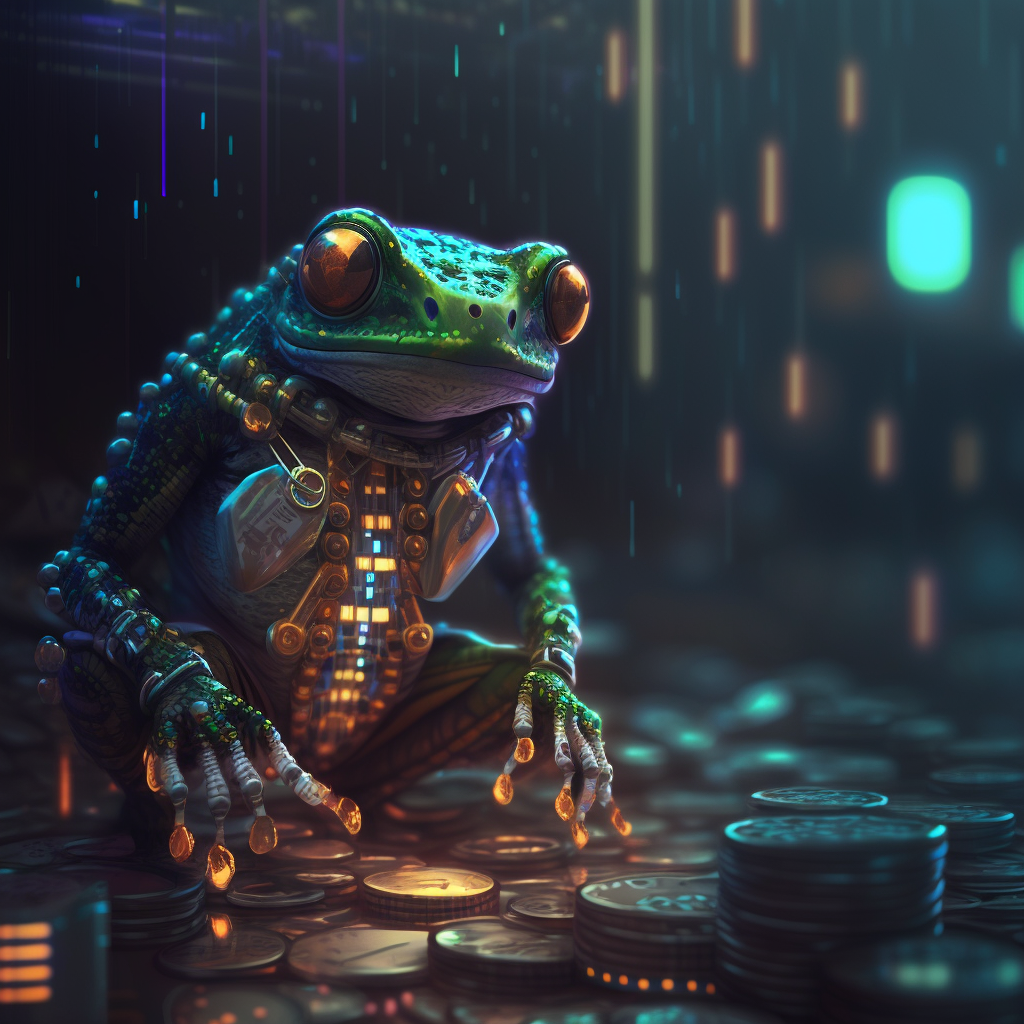
If you were active on Crypto Twitter on Valentine’s Day 2023, there’s no doubt you either heard about or were a participant of the $BLUR token airdrop. It was impossible to scroll through your timeline without seeing the same canned tweet people were required to share to claim their tokens. For those who opted to take a break from the space due to the bear market or if you are joining us as a newcomer, let’s talk about how Blur has disrupted the landscape for NFTs and why the $BLUR token airdrop was such a big deal.
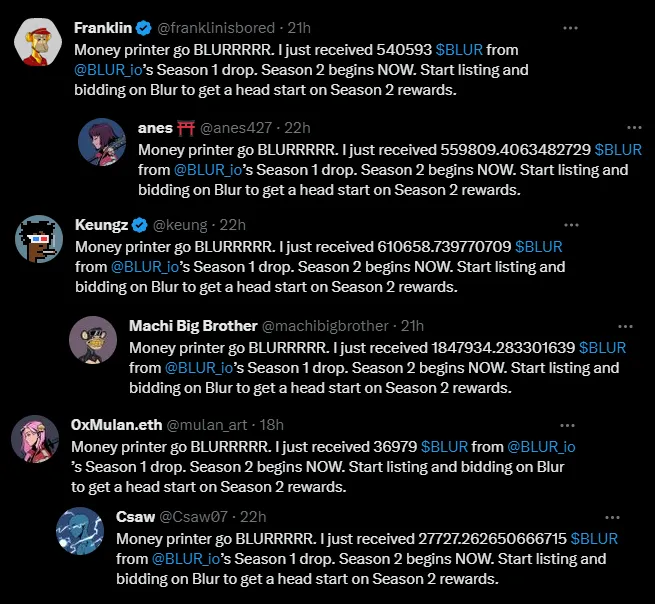
Brief History of NFT Marketplaces
To fully understand why Blur has gained so much mindshare lately, it’s worth providing some context to help paint the picture. Luckily, the NFT space is still nascent so a brief history lesson won’t take too long.
Opensea was the NFT marketplace on Ethereum when NFTs started to gain mainstream traction in 2021. Despite its flaws and limitations causing the site to crash during heavy traffic for hotly anticipated NFT launches, it secured itself as the #1 NFT marketplace. Since the NFT boom, crypto natives pleaded for Opensea to issue an ERC-20 token that they can buy to gain indirect exposure to the success of the platform. It was clear that Opensea was highly successful and had a strong revenue stream due to the platform raking in 2.5% of every NFT sale. According to @rchen8’s Dune Analytics dashboard, in August 2021 alone Opensea pulled in $3.4b in NFT volume which translates to $85m in revenue. However, instead of issuing a token to past users of the platform like most dApps, Opensea opted for doing a funding round and eventually closed on a $300m funding round valuing Opensea at $13.3b!
Fast forward a year later, many competitors have popped up, some armed unique approaches to try and claw away marketshare from Opensea while others relied on their brand. LooksRare gave a free $LOOKS airdrop claim for existing NFT traders and rewarded traders on their platform. X2Y2 tried to vampire attack market share by removing royalties on NFT sales, incentivizing short term traders to trade on their platform. Coinbase NFT launched and exists but no one actually uses it. In the end, Opensea still reigned supreme. To this day, there are people who are familiar with Opensea and will only shop there despite there being better alternatives, including aggregators like Gem that can show you listings across all marketplaces.
As the crypto bear market started to become real in Q3 2022, NFT volumes plummeted and all marketplaces ended up fighting over the continually shrinking pie of NFT volume. While X2Y2’s approach of reducing fees on trades ended up becoming controversial due to creators no longer having a constant revenue stream to count on, the NFT market as a whole ended up trending towards a race-to-the-bottom approach on trading fees in a desperate attempt to entice traders to continue to trade NFTs. Enter Blur.
A New Challenger Appears
Blur first launched in August 2022 as a closed beta where only the most prolific NFT wallets were permitted to use the platform and give feedback to the team. After a couple months of fine tuning in collaboration of the NFT community’s best traders, Blur’s multi-stage plan to attract NFT traders to their platform went live in October:
- Phase 1: Give anyone who traded NFTs the past 8 months Care Packages so long as you use the platform once. Anyone trying to claim their Care Packages will have to briefly get familiarized with Blur as a zero fee marketplace and aggregator. They also incentivized people to list their NFTs in order to quality for a second airdrop in December. This was wildly successful and already pinned Blur as the #2 NFT marketplace.
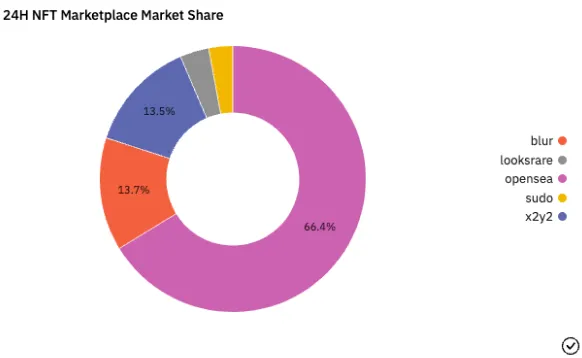
- Phase 2: After everyone became familiar with Blur in order to qualify for the second airdrop, they followed that up by rolling out a new feature: collection bidding. They incentivized bidding with yet another airdrop based on points received as a bidder. The closest bids to the floor received the most points and a public leaderboard was accessible, giving whales with the largest ETH stacks the ability to flaunt their farming prowess.
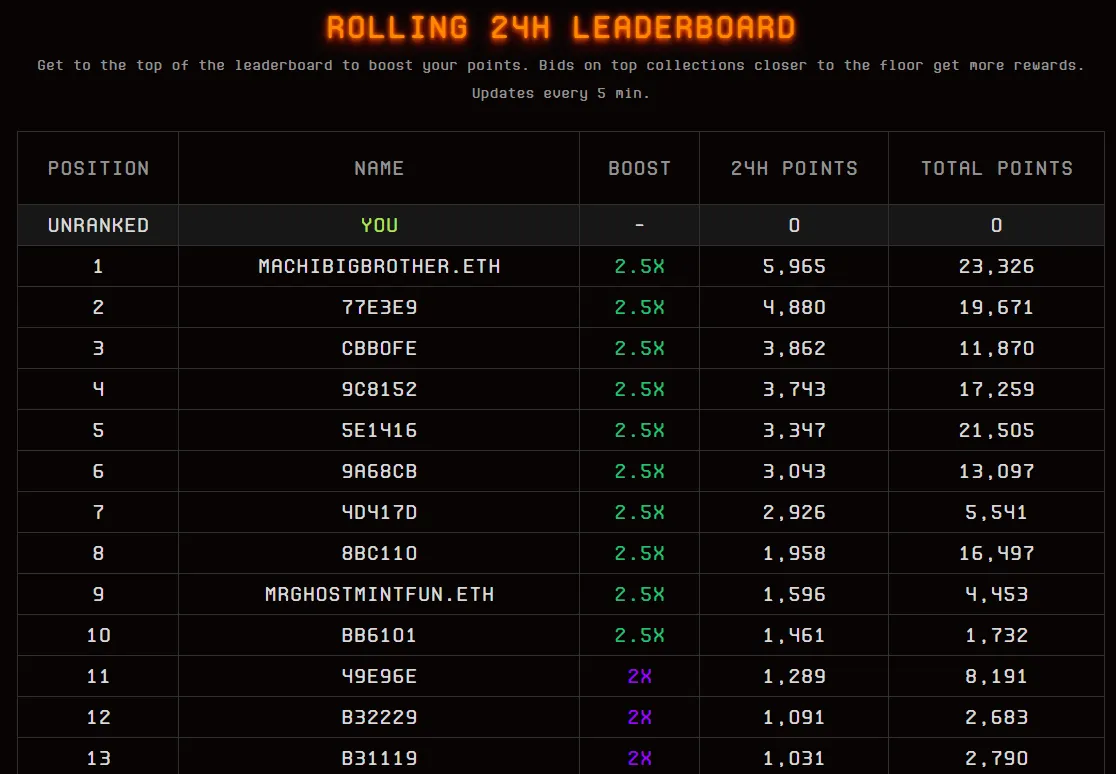
- Phase 3: $BLUR token launch. On February 14th 2023, the bid rewards concluded and everyone’s bid points turned into more Care Packages. Care Packages from all three airdrops can now be opened and claimed so long as you were not a US citizen. Ethereum gas prices sky rocketed to ~700 gwei as people rushed to claim and sell their $BLUR tokens. Blur would also announce that the past 4 months of activity was just Season 1 of incentives and Season 2 of listing and bidding incentives begins today. Given the success of the $BLUR token launch, even more people are using Blur with the Blur bidding pool now reaching $132m in TVL and total NFT volume heavily in Blur’s favor.
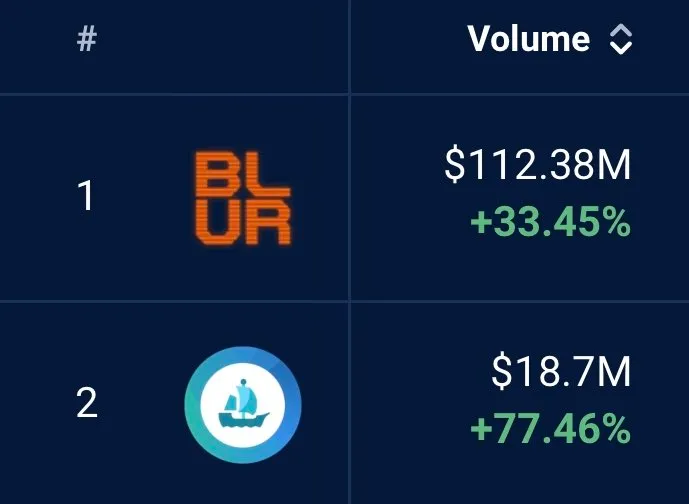
Blur’s platform and token launch was so successful that Opensea was forced to acknowledge Blur and try retaliate. On February 17th, Opensea released a Twitter thread stating that they will be matching the low royalties that are present on Blur in an effort to bring traders back to their platform. At the end of the thread, Opensea also teased a reward for their loyal users. Many are speculating that Opensea saw the wild success of the $BLUR token and feel the need to release their own token just to stay relevant.
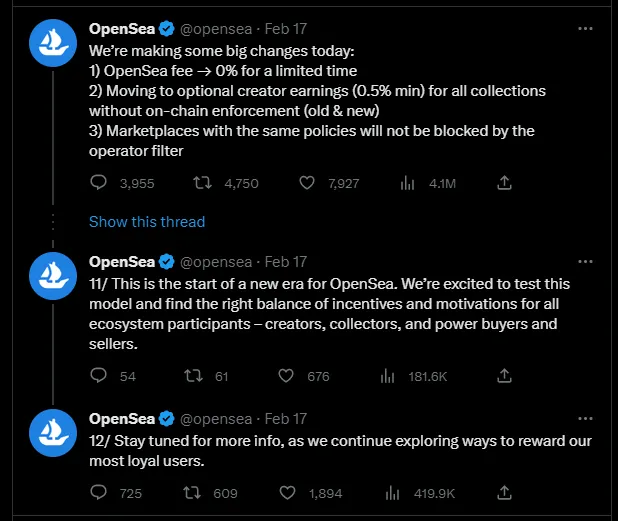
Post-Mortem: Why Was Blur Successful?
Blur was not the first NFT marketplace to have a token to entice users to come use their platform. What made Blur different was that instead of fixating on incentivizing trading volume, they incentivized listing and bidding. Couple that with zero marketplace fees, it became a no brainer for NFT traders to at least use Blur in addition to their favorite marketplace since you would then be rewarded with Care Packages. Focusing on bringing NFT listings and bidders also dodges the common problem of wash traders showing up and farming tokens — if you want $BLUR, you must to have skin in the game by exposing yourself to the risk of buying or selling an NFT on their marketplace.
The timing of their launch also contributed to their success to win over NFT traders. By the time they launched in October, the bear market was very much real and affecting everyone. When times are bad, people often play the blame game and Opensea had began to be seen as a leech in the ecosystem by taking a 2.5% fee on all trades on their platform. This fee doesn’t go to the trader’s PnL, and it doesn’t go to the collection creator as financial runway. It just goes to Opensea, the company that still struggles to handle big launches despite receiving $300m in funding over a year ago.
Blur’s decision to take 0% on all trades since inception has helped build its reputation as the go-to marketplace for traders that doesn’t suck away NFT liquidity slowly over time. This perception of being likeable would later be bolstered due to the fact that the $BLUR token has only appreciated in value since it launched. Just 24 hours after $BLUR became claimable, the token price would eventually surge past $1. Given that 360 million tokens were given to the community who used Blur, that essentially means the NFT economy was given a ~$360m stimulus for doing nothing but participating. If you’ve been in crypto long enough, you will know that giving your community a sizeable amount of free money is a fantastic way to win over loyalty.
Looking Ahead
It’s hard to say if Blur’s dominance can be maintained as Opensea tries to claw back its place in the market. It’s also hard to tell if the activity level on Blur would still be strong if the token price for $BLUR drops significantly. However, Blur has thought out a plan for $BLUR both pre-TGE and post-TGE. If you go to the Blur’s website, you will see an “idea map”, which is full of teasers of things to come, not unlike a typical NFT project’s roadmap. While the future is uncertain, the only thing that we know for a fact is that competition is great for everyone. Opensea has been complacent for far too long and they finally see that now.
Any views expressed in the below are the personal views of the author and should not form the basis for making investment decisions, nor be construed as a recommendation or advice to engage in investment transactions. As always, please do your own research. This is not financial advice. Every strategy is not for everyone. Each investor needs to understand what is right for them.
Anime PFP Maxi Steven has proven to be a JPEG flipper of the highest order. While starting out as one of the resident Technical Analysis experts on shitcoins, Steven was slowly pilled on the virtues of NFTs -- especially those of the weeb variety. When he isn't using you as exit liquidity Steven enjoys long walks on the beach and intimate, candle lit dinners at McDonald's.